
Film can with soap film over opening
What light through yonder film can breaks?
Introduction
A black film can makes an excellent container for a soap film. The colors of a soap film are bright against the black background of the can.
Material
Assembly
Make bubble solution
Mix 1 part Dawn in 16 parts water, (1 cup of Dawn in 1 gallon of water.)
Fill a shallow dish 0.5 to 1 cm (1/4-1/2 inch) deep with the
bubble solution.
Remove the lid from the film can.
Place the white paper on a table top.
To Do and Notice
Dip the open mouth of the film can into the soap solution. Pull it
out.

Film can with soap film over opening
Hold the film can over the white paper in a brightly lit place.
Hold the film can so that the soap film is in a vertical plane.
Watch the colors form and move in the film.
Notice the horizontal bands of color.
Notice that after a while the top of the film becomes invisible.
If you poke a pencil point into the invisible region of the film it
will break.

The top half of this soap film is much thinner than a wavelength of
light, under 300 nm thick.
What's Going On?
The soap film is a water sandwich. A layer of water is held between two layers of soap molecules. When the soap film is vertical the water drains down under the pull of gravity so that the top of the film becomes thin while the bottom becomes thick. Light reflects from the front and from the back of the soap film. The two reflections add up producing interference of light. Some wavelengths &emdash; colors &emdash; add up out of phase and are canceled while other colors add up in phase and are strengthened. Different thicknesses of soap film cancel different colors. This produces the bands of color you see in the film can.
The light waves reflected from the front of the soap film are inverted while those from the back are not. Thus, soap films that are thin compared to all wavelength of light reflect no light at all. They are invisible because they are transparent and also reflect no light. And yet, touching the invisible soap film with a pin reveals its presence because the entire soap film breaks.
Going down the film until it is 1/4 wavelength of blue light in thickness the blue light is reflected strongly. At this point the film is about 1/8 of a wavelength of red light thick (the wavelength of red light is just under twice that of blue.) So some red light is reflected. The result is that the transparent film thickens into a metallic white sheen that grows bluer and bluer.
When the film is 1/2 of a wavelength of blue light thick the blue waves cancel, it is also 1/4 the wavelength of red light thick so that the red light adds together. the color band is therefore reddish.
Every integral multiple of 1/2 blue wavelength, blue light is removed, every odd multiple of 1/4 wavelength blue light is strengthened. Every multiple of 1/2 wavelength of red light, the red light is strengthened. The result is alternating bands of bluish and reddish light as the film grows thicker.
Etc
Robert Hooke first reported observing the transparent film in a letter to the Royal Society. His letter indicates that he thought that the film actually did not exist where it was transparent but that some force held the bubble film in place. A simple experiment of poking the invisible film and so breaking it proves the existence of the invisible film.
Etc
The colors in the soap films are like contour lines on a
topographic map. reddish bands of color show thicknesses of the soap
film differing by integral multiples of 1/2 a wavelength of red
light.
References
Soap Films, CV Boys
Further Explorations:
Drill a 0.5 cm diameter hole in the bottom of the film can.
Create a soap film over the mouth of the film can, then blow through the hole. The soap film will bulge out into a dome.
Allow the air to rush out of the hole. Notice the dome flatten out. Feel the gentle breeze coming from the hole. Or show it by holding the hole near a candle flame. The pressure in the film can is greatest when the radius of curvature of the dome of soap film is least. The interesting thing is that when the dome is largest, the radius of curvature is least. So the larger the bubble the higher the pressure and the faster the air rushes out of the can. The soap film dome thus deflates most rapidly at first and slows down as it flattens.
If you plug the hole and place the film can with the opening facing upward surmounted by a dome of soap film, colored rings will appear in the soap film.
|
Scientific Explorations with Paul Doherty and Linda Hjelle |
|
24 May 2000 |